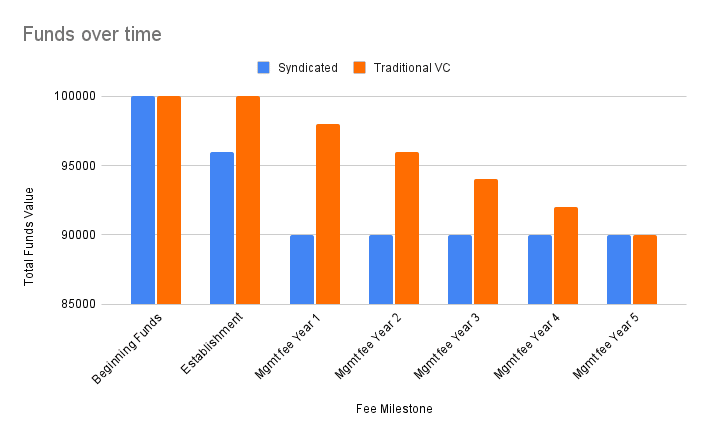Fees for investors in the venture capital industry often carry some level of confusion as there are a myriad of options depending on whether the Venture firm runs a fund or a syndicated model on a deal-by-deal basis. The number and conditions of the fees can have a significant impact on the net amount invested and the longer term return.

Venture Capital funds
The most common fund management fee structure is the two and twenty fee arrangement (2 and 20) that charges 2% of funds under management and 20% for performance fees (also called carried interest). This has been the expectation for the industry as it incentivises fund managers to perform well while giving some guaranteed income to keep the fund running. However, it is not the only fee structure, as in 1956 Warren Buffett himself ran a 0% management fee structure and 25% performance fee structure in his first investment partnership showing that there are alternative options available.
Management fees have some level of manoeuvrability depending on the time or age of the fund. Normally these fees are accrued on a straight line basis across the funds life where the example of 2% rule is used every year. However, there can sometimes be a “step-down” after a milestone is met whereby the 2% management fee is charged on invested capital rather than the original committed capital to reflect the new status of the fund once investments have been sourced.
The order in which funds pay out returns is also necessary to be considered. Similar to a clawback provision, funds will often pay back every dollar that was invested by the LP’s before “carried interest” is given to the General Partners. This means that if a portfolio company is acquired for an amount of money equivalent to 80% of the fund investment, all of that money will go to the investors themselves and the performance fee will not yet kick in. This ensures that the investors are given some security and the GP’s are further incentivised to generate the highest returns in a reasonable period of time.
Furthermore, unlike some syndicates, Venture firms can offer an additional layer of protection for investors and will sometimes provide a minimum “hurdle” on expected returns.
This is traditionally set at 8% which means if the fund does not meet the required amount, the performance fee of 20% will also not be enforced. Alternatively, if a fund has an invest and hold strategy where they do not exit investments for 15-25 years, the hurdle rate is not appropriate. So instead, they may opt for a set “high-water mark” which is essentially a limit of what the total value of the fund has reached through updated valuations. Due to the investments not realising value for an extended period of time, the fund managers may not be able to wait until there is a liquidity event to receive compensation and continue operating the business. So this instead allows them to draw funds once the investments have grown to a predetermined size.
Syndicated Venture models
A modern example for Venture firms that use differing fee structures are those who operate syndicate or “deal-dy-deal” arrangements.
These investors are often charged an “establishment fee” that goes directly towards the costs associated with due diligence, legal documentation and administration expenses for a particular investment. The fees for this structure will vary between 2.5% to 5% of the total funds pledged, versus 1-2% that a standard fund might charge. Some syndicates even charge the management fees upfront too, seeing the investor being out of pocket for up to 10% of their funds before they even invest in the deal!
Generally syndicates will charge some level of performance fee to give incentive for the management team to continue providing high quality recommendations and proposals. Although there are examples of deal-by-deal investors not charging a “performance hurdle” of at least 8%, which is not favourable for the wholesale or family office investor as the VC will get their 20% no matter what.
For performance fees that are on a deal-by-deal basis, there is often an additional “clawback provision” embedded into the fund agreement. This is to ensure that if the specific investment fails to generate a benchmark return the Limited Partners (LPs) can recoup a portion of their losses. Ultimately, this is higher risk, with a higher potential reward fee arrangement than the traditional 2 and 20 model which enables investors to handpick investments and directly share in the success or failures.
The number and variability of incentives are why the simple 2 and 20 model has become the industry standard when it comes to management fees within the Venture and funds management space. As is often the case, the more unique a fee structure is for a fund, the more likely it is to deter new investment because they come with benefits and drawbacks usually at the cost of performance or risk.
Ready to invest with Sprint? Discover where we invest or explore investing with Sprint and let’s start something extraordinary.




